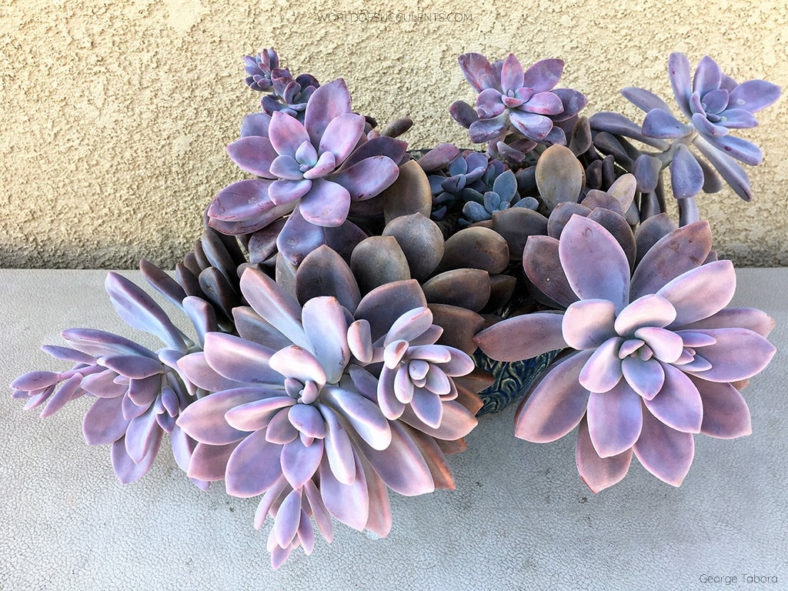Scientific Name
Graptopetalum 'Murasaki'
Scientific Classification
Family: Crassulaceae
Subfamily: Sedoideae
Tribe: Sedeae
Subtribe: Sedinae
Genus: Graptopetalum
Etymology
The hybrid name "Murasaki" means "purple or violet" in Japanese and refers to the color of the foliage.
Origin
This succulent is an Altman Plants original hybrid created by Renee O'Connell. It results from a cross between Graptopetalum superbum and an unknown Graptopetalum species.
Description
Graptopetalum 'Murasaki' is a gorgeous shrubby succulent that forms short-stemmed rosettes of fleshy, pastel, purplish-pink leaves with a powdery coating. It resembles its parent, Graptopetalum superbum, but has more rounded leaves. The rosettes can grow up to 4 inches (10 cm) in diameter. The color of the leaves becomes more intense under bright sunlight.
The flowers are star-shaped, usually 5-merous, and appear in late winter and spring. They are pale yellow with reddish-brown markings that become confluent at the tips of the lobes.

How to Grow and Care for Graptopetalum 'Murasaki'
Light: G. 'Murasaki' thrives in sunlight, so choose a location where it will receive full sun. However, it will also grow in partial shade with slightly rangy results. Therefore, keep it near a sunny window when grown as a houseplant.
Soil: The plant needs good drainage to maintain a healthy root system. When growing G. 'Murasaki' in a pot, choose a well-drained soil mix and a pot with drainage holes.
Temperature: This plant will do well in hot weather, but its most active growth will occur in spring and fall. G. 'Murasaki' can withstand temperatures as low as 30 °F (-1.1 °C). USDA Plant Hardiness Zones 10a to 11b, 30 to 50 °F (-1.1 to 10 °C).
Watering: The plant growing outdoors in full sun will appreciate a weekly watering in the summer. When the weather cools down in spring and fall, cut back on watering to about every 10 to 14 days. Rather than giving the potted plant little splashes of water here and there, give it a good soaking until water runs out the drainage holes, then wait for the soil to dry out completely before watering again. In winter, water the plant just enough to keep it from shriveling.
Fertilizing: Apply fertilizer to promote healthy growth, including flower production. Fertilize during the active growing season. A water-soluble fertilizer diluted to half the recommended strength is suitable and commonly used.
Repotting: G. 'Murasaki' does not need frequent repotting. When your plant has outgrown its container, repot it in a fresh potting mix in a new pot that is slightly larger than the old one. Give the plant a week or so to readjust before you water it.
Propagation: The easiest way to propagate G. 'Murasaki' is through stem cuttings. It also easily propagates from leaf cuttings. Even a leaf that drops off quickly roots below the parent plant and produces a new rosette. The best time to take cuttings is spring and summer.
Learn more at How to Grow and Care for Graptopetalum.
Toxicity of Graptopetalum 'Murasaki'
G. 'Murasaki' is generally non-toxic to humans and animals.
Forms of Graptopetalum 'Murasaki'
Links
- Back to genus Graptopetalum
- Succupedia: Browse succulents by Scientific Name, Common Name, Genus, Family, USDA Hardiness Zone, Origin, or cacti by Genus
Photo Gallery
Click on a photo to see a larger version.


